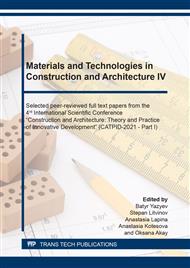[1]
V.I. Solomatov, V.P. Selyayev, Reagent resistance of composite building materials, Stroyizdat, Moscow, (2002).
Google Scholar
[2]
Recommendations for the use of protective and structural polymer solutions in the reconstruction and construction of civil buildings, Stroyizdat, (1981).
Google Scholar
[3]
J. Oudian, Fundamentals of Polymer Chemistry, edited by Z.G. Rogovin, Chemistry, Moscow, (2006).
Google Scholar
[4]
P.I. Zubov, L.А. Sukhoreva, Structure and properties of polymer coatings, Chemistry, Moscow, (2009).
Google Scholar
[5]
Ngog Thanh Tran, Fracture energy of ultra-high-performance fiber-reinforced concrete at high strain rates, Cement and Concrete Research. 101 (1) (2015) 80-90.
DOI: 10.1016/j.cemconres.2015.09.011
Google Scholar
[6]
V.I. Solomatov, A.N. Bobryshev, K.G. Himmler, Polymer composite materials in construction, Stroyizdat, Moscow, (2001).
Google Scholar
[7]
K.I. Chernyak, Epoxy compounds and their applications, Shipbuilding, Leningrad, (1985).
Google Scholar
[8]
M.K. Mohammeda, A.I. Al-Hadithi, M.H. Mohammed, Production and optimization of eco-efficient self compacting concrete SCC with limestone and PET, Construction and Building Materials. 197 (2019) 734–746.
DOI: 10.1016/j.conbuildmat.2018.11.189
Google Scholar
[9]
I.P. Losev, E.B. Trostyanskaya, Chemistry of synthetic polymers, Chemistry, Moscow, (2008).
Google Scholar
[10]
R. Foreman Matthew, Vollmer Frank, Optical Tracking of Anomalous Diffusion Kinetics in Polymer Microspheres, Physical Review Letters. 114 (11) (2015) 257-266.
DOI: 10.1103/physrevlett.114.118001
Google Scholar
[11]
A.M. Gadzhiev, R.M. Kurbanov, G.N. Khadzhishalapov, The influence of the filler grain composition on the properties of the heat-resistant basaltic, Herald of Daghestan State Technical University. Technical Sciences. 44 (3) (2017) 146-155.
DOI: 10.21822/2073-6185-2017-44-3-146-155
Google Scholar
[12]
R.A. Burkhanova, T.K. Akchurin, I.V. Stefanenko, Modified heat-resistant concrete using slag aggregates, IOP Conference Series: Materials Science and Engineering. 962 (2020) 9. https://iopscience.iop.org/article/10.1088/1757-899X/962/2/022015/pdf.
DOI: 10.1088/1757-899x/962/2/022015
Google Scholar
[13]
R.A. Burkhanova, N.Yu. Evstafieva, T.K. Akchurin, Filling of epoxy polymers as a factor in obtaining a multicomponent composition with improved strength properties, Bulletin of the Volgograd State University of Architecture and Civil Engineering. Building and architecture series. 4 (81) (2020) 151-161.
DOI: 10.1007/978-3-030-91145-4_9
Google Scholar
[14]
Sun Hongfang, Zishanshan Li, Shazim Ali Memon, Influence of ultrafine 2CaO center dot SiO2 powder on hydration properties of reactive powder concrete, Materials. 8 (9) (2015) 6195-6207.
DOI: 10.3390/ma8095300
Google Scholar
[15]
M. Skazlic, Z. Skazlic, J. Majer, Application of high performance fibre reinforced shotcrete for tunnel primary support, Proceedings of the 10th International Conference. Shotcrete for Underground Support, (2012) 206-214.
DOI: 10.1061/40885(215)17
Google Scholar
[16]
X.S. Shi, E.G. Collins, X.L. Zhao, Mechanical properties and microstructure analysis of fly ash geopolymeric recycled concrete, Journal of Hazardous Materials. 237 (2012) 20-29.
DOI: 10.1016/j.jhazmat.2012.07.070
Google Scholar
[17]
R.A. Burkhanova, T.K. Akchurin, V.V. Vovko, Modified heat-resistant concretes using slag aggregates, Bulletin of the Volgograd State Architectural and Construction University. Building and architecture series. 3 (80) (2020) 54-63.
Google Scholar
[18]
Sudarsana Rao H., H.M. Somashekaraiah, G. Ghorpade Vaishali, Strength and workability characteristics of fly ash based glass fibre reinforced high-performance concrete, International Journal of Engineering Science and Technology. 3 (8) (2011) 6266-6277.
Google Scholar
[19]
N.Yu. Evstafieva, T.K. Akchurin, I.V. Stefanenko, Polymer systems of waterproofing and anticorrosion protection of building materials and structures, Bulletin of the Volgograd State Architectural and Construction University. Building and architecture series. 53 (72) (2018) 43-52.
Google Scholar
[20]
N.Yu. Evstafyeva, I.V. Stefanenko, T.K. Akchurin, Modification of concrete with polymer additives based on secondary resources, Material Science Forum. 974 (2020) 277-282.
DOI: 10.4028/www.scientific.net/msf.974.277
Google Scholar
[21]
N.Yu. Evstafyeva, I.V. Stefanenko, T.K. Akchurin, Polymer system for the protection of building products from corrosion damage, Resource-energy-efficient technologies in the building complex: collection of scientific articlesbased on materials from VӀӀInternational scientific-practical conference Saratov state technical university named after Yu.A. Gagarin (2019) 194-199.
DOI: 10.17587/mau.16.337-343
Google Scholar
[22]
N. Spiratos, Superplasticizers for concrete. Quebec: Fundaments, technology and practice, (2015).
Google Scholar
[23]
A.I. Reibman, Protective paints and varnishes, Chemistry, Moscow, (2002).
Google Scholar
[24]
M.N. Balakrishna, F. Mohamad, R. Evans, Durability of concrete with differential concrete mix design, International Research Journal of Engineering and Technology (IRJET). 7 (4) (2020) 696-701.
Google Scholar
[25]
A.I. Al-Hadithi, N.N. Hilal, The possibility of enhancing some properties of self-compacting concrete by adding waste plastic fibers, Journal of Building Engineering. 8 (2016) 20-28.
DOI: 10.1016/j.jobe.2016.06.011
Google Scholar
[26]
S.N. Zhurkov, V.S. Kuksenko, A.I. Slutsker, Micromechanics of Fracture of Polymers, Problems of Strength. 2 (1971) 45 – 50.
Google Scholar
[27]
G.E. Zaikov, Yu.V. Moiseev, Chemical stability of polymers in aggressive liquid media, Plastic mass. 11 (1972) 24 – 27.
Google Scholar


